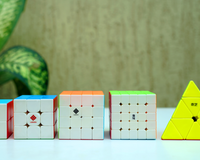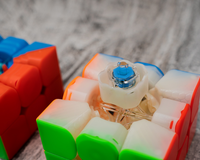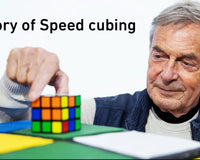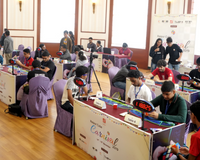All of you reading this article know how to solve a 3x3. You may be using the beginners method which is also called the layer by layer or using the modern and popular method CFOP. CFOP method stands for Cross, F2l, Orienting last layer and Permuting last layer. The formula does not change and all your solves can be broken down into these 4 steps. There are various subsets like ZBLL, 1LLL, VLS that you can try and include in your repertoire to make your solves faster and have less move count. The start of the solve is constant, as we have to solve cross edge pieces and potentially block build a 2x2x2 square, tldr make a xcross. The xcross can be on any color but most of the solvers stick to white and yellow cross which is called dual color neutral. Let me be clear here, color neutrality is an old concept and it was devised to overall save 1 move in cross move count and give easier xcrosses overall. It is by no means related to the method neutrality concept that I am about to introduce here.
What is Method Neutrality?
Method neutrality is the concept where you try to inspect the puzzle in various methods and choose the one which gives the best start. This concept already exists for the puzzles of Pyraminx and 2x2 as there are various methods which are good for various scrambles, and sticking to one method of solving is not the only option in order to get the most efficient solutions. For the 2x2, we have EG, EG2, SOAP, CLL, Ortega etc. For the Pyraminx we have, L4E, Top first, Oka etc. At the elite level, it is possible to one look 2x2 and Pyraminx easily and one-looking becomes much easier if we can recognise more patterns. For 3x3, the most popular methods are CFOP, Roux, ZZ and Mehta. They are called the big 4 and there are a few people who are comfortable and at a good level in more than one method.

1. History of 3x3 Methods
With the WR single of 3x3 getting to insanely fast 3.47 seconds, we have to rethink on whether 3x3 is a luck based puzzle or do we need to use different methods to gain maximum advantage and get nice efficient solutions. The easiest and the most braindead approach is to get high turn speed and fluidity in the one method that you are using and turn your solving session into TPS slugfest, or we can try and get creative and explore ideas like method neutrality. We can just stick to the ever-popular method of CFOP and continue improving on it but there is no harm in exploring more and making your solves look more creative. The timeline of how the 3x3 solving has evolved over the years looks like this. In 1985, Waterman Method was used in speedsolving at WC 1985. The CFOP method was not introduced yet. In 2008-, Dayan Zhanchi and the new set of fingertricks were introduced to the cubing world. In 2009, the first ever official sub-10 using CFOP was achieved, and Feliks became a dominant for a few years. In 2016, we saw the first official sub-5 with CFOP and Rouxavolution started gaining traction. In 2017, magnetic Cubes and faster turning were introduced to the cubing market. In 2018, we got to see the first sub-4 3x3 solve ever recorded in a comp. So cubing has come a long way and we are at the stage where we have to think of the next step. One of the ways of making progress is for top solvers to be method neutral.

Waterman Method
2. Method Neutrality being proposed in 2019
Method neutrality was proposed by me in 2019, when I gave a cubing seminar at Indian Nats 2019. It received mixed feedback back then. The concept has gotten more fine-tuned and evolved now. One of the main questions that I tried to address then was on how to inspect multiple methods under the 15 seconds of inspection that we get in WCA competitions. There are various combinations possible like CFOP+Roux, Roux+Mehta, CFOP+Mehta, CFOP+ZZ etc. The rarer combinations are Roux+ZZ, ZZ+Mehta but they are also viable.

3. Tips on using more than one method in actual solves
Social anxiety and overall solving anxiety is always present in 3x3 solving. The issue gets compounded by such a short span of inspection with warnings at 8 and 12 seconds to make competitors more nervous. The CFOP inspection can get quite complex if you are looking out for xcross or cross solution on other colors, color neutrality. My solution for easier adapting to method neutrality is to learn to do only one or two cross colors, and then a few blocks in the other method that you choose (Roux or ZZ). I do not think full color neutral CFOP inspection and x2 y Roux inspection is possible in 15 seconds. We sometimes have to go by our gut and choose the first promising solution that we see.
TL;DR here are some basic tips that can help you improve as a method neutral solver:
- Use your inspection time wisely
- Look for blocks, if its a square, line or a 2x2x2 block, make good use of it using any method
- Trace well during the inspection in order to plan out FB or Xcross
- Go with the first solution that you find (This need not be the best solution for any method on that scramble)
- Try to be confident in both the methods
- Maintain good fluidity and turning speed for whichever method you decide to execute after the inspection
- Final and the most important tip: Don’t think, just solve

Conclusion
Method neutrality is an ambitious concept and is definitely viable and a good method to pursue. Method neutrality requires a lot of practice to get good at and it is a tough skill to maintain. Also it requires a lot of prior knowledge as we need to be good at and at the same level in two or more methods which is rare to find in a beginner cube or an intermediate cuber. A cuber who has tried and tested one method, who has heard about other methods and explored it a bit and overall have a lot of curiosity and free time at their disposal should pursue method neutrality. Personally, I try to inspect 3 methods when I am trying to do a 3x3 speedsolve, I look for CFOP, Roux and 3-style and choose the one that looks to be the easiest to start with. I would be happy if any reader of this article decided to try it out and experiment with it. It is not impossible as long as you continuously work towards it.
About Author

Abhijeet Ghodgaonkar
Abhijeet Ghodgaonkar is the current 4x4 Blindfold (single) National Record holder from Mumbai. He started cubing when he was 13 and he has an overall competitive experience of 8 years. His main events are 5BLD and MBLD. He has been developing concepts like letter quads and 5-style since 2017, to make blind-solving events more structured. He has participated in 50 competitions in a total of 3 countries and won 105 podiums with 51 Gold medals, 2 Asian Continental Records, and 3 National Records. He also has a World Ranking of 29 in 4x4 Blindfolded Single.






























